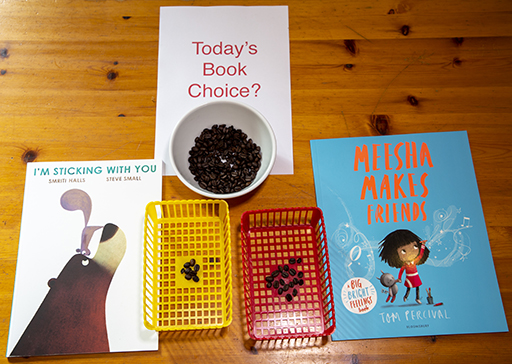3 Making read aloud LIST
In order to maximise the influence of reading aloud on developing volitional reading, it needs to be Learner-led, Informal, Social and with Texts that Tempt (LIST).
Learner-led read-aloud
Child-led/shaped reading aloud is valuable in addition to teacher-led reading aloud. For example, Moffatt et al.(2019, p. 159) found that when 3-6-year-olds ‘were positioned, and positioned themselves, as readers in their own right daily’ this had advantages. They signed up to read enthusiastically and they were permitted to take ownership of ‘the reader’s chair’ giving them status as readers.
Another way to make read-alouds more learner-led is for teachers to offer a choice of texts for the daily read-aloud, with children then voting with counters, as in Figure 3. Alternatively, when asking children to select a class novel, several books that are all related to the history theme to be studied or to their interests, for example, can be offered. Book promotion on each text can then take place before a class vote.
Informal reading aloud
In seeking to ensure that reading aloud is offered in a relaxed environment many teachers choose to invite children to gather around them. Some choose to sit on the floor with children to reduce any implicit hierarchies, though much will depend on the space and age of the children. Another aspect of informality relates to the low-key opportunities offered to interact, so children participate freely and share their thoughts with one another in small groups in a non-assessed manner. This is not a time for teacher-led comprehension.
Social read-aloud
While discussions can extend children’s thinking (McClure and Fullerton, 2017), it is vital to balance the skill with the will, and ensure conversations are inclusive and reader to reader. As noted by research (Hempel-Jorgensen et al., 2018), if children are mainly positioned as listeners and respondents to teachers’ targeted information-retrieval questions, they will be prevented from asking their own questions, and from making connections and personal responses.
Children’s questions and thoughts are key. Using drama techniques, such as freeze frames of a likely narrative event in the forthcoming chapter can help to prompt children to embody their predictions and increase engagement. Many teachers additionally invite children to draw during read-aloud, and offer opportunities for discussion before, during and following it. This ‘extra-textual’ talk can have positive consequences.
Reading aloud from texts that tempt
Reading aloud is often equated with ‘storytime’ – the sharing of rich narrative texts. As you learnt in Session 3, fiction is uniquely powerful, but teachers will want to read aloud from a far wider range of genres in response to the children’s preferences.
The texts need to tempt your children. Getting children involved and encouraging them to establish their views is also beneficial, particularly for the less engaged readers.

Optional resource
For more ideas and strategies to refine and shape reading aloud for RfP [Tip: hold Ctrl and click a link to open it in a new tab. (Hide tip)] , see The Open University’s Reading for Pleasure website.

